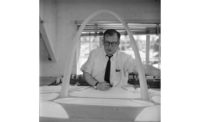Eero Saarinen: Furniture for Everyman
This is a book on the model of Marilyn and John Neuhart’s The Story of Eames Furniture (Gestalten, 2010). It shares with that two-volume set an agenda—an emphasis on process and manufacturing—and a large size (14.2 by 11.8 inches) that does neither the reader nor the illustrations great service.

First, the agenda. Lutz, a former Knoll associate, argues in his introduction that Saarinen’s furniture has never attracted the same scholarly interest as his architecture, and he aims to rectify that omission by placing Saarinen’s key pieces (the Grasshopper, the Womb, the 70s Series , and the ineffable “Tulip” chairs—as the Pedestal chairs are often called) in context. The book is lavishly illustrated with sketches, patent applications, and process photographs from the Saarinen archives at Cranbrook, Yale, and Knoll Inc. It usefully reinstates the manufacturers of the early fiberglass and bentwood pieces as essential players in the creative process and correctly refers to the furniture innovations of other modernists, including Alvar Aalto, Marcel Breuer, and Charles Eames as influences. It is large and handsome, though hard to read, given its dimensions. Having the captions run the full width of the text column is also unkind to the nearsighted; blowing up period images that large often makes them grainy, also a problem in the jumbo-size Alexander Girard monograph published by AMMO in 2011.
But ultimately, I don’t think the book proves its necessity. Saarinen’s furniture is hardly ignored in the popular press, and has been discussed by Lutz himself in a chapter in the essential Saarinen exhibition catalog, Eero Saarinen: Shaping the Future (Yale, 2006) to which I also contributed two chapters, as well as in Jayne Merkel’s 2005 Phaidon monograph on Saarinen. (Disclosure: Merkel is a contrib uting editor to Record and edits the book reviews.) Oddly, in his bibliography, Lutz fails to cite his own chapter. While the Pedestal series is ubiquitous, it is the less flashy 70s series of office chairs that can truly be said to have been used by “everyman.” These side chairs were developed in tandem with Saarinen’s first large corporate commission, the General Motors Technical Center, and I believe are more interesting seen in the context of the expanding modernist office, where furniture, cubicle systems, and architecture worked together. For the Saarinen connoisseur, a book on the furniture makes sense, but a better model would have been Christopher Wilk’s compactly sized and modestly priced Marcel Breuer; Furniture and Interiors (Museum of Modern Art, 1981), which offers detailed information and useful interpretation of how these smaller-scale design enterprises went together. Lutz’s tome has the information, but not the interpretation. What’s the back-and-forth between the “Tulip” and TWA? How do his office chairs relate to the history of ergonomic seating? (Niels Diffrient, the former Saarinen employee who contributed an essay, could probably have told us before he died in June.) This book has a chapter at the end on interiors, but it reads more like an excuse to run gorgeous period images, and includes a digression on the Tangier villa of Yves Vidal and Charles Sevigny. Because Eero Saarinen: Furniture for Everyman can’t be the only Saarinen book you own—setting aside the architecture is impossible—I wish publisher Pointed Leaf Press had shaped and promoted this book as less of an event and more of a treat for the truly obsessed.
Alexandra Lange is an architecture and design critic, and the author of Writing About Architecture: Mastering the Language of Buildings and Cities (Princeton Architectural Press, 2012).





